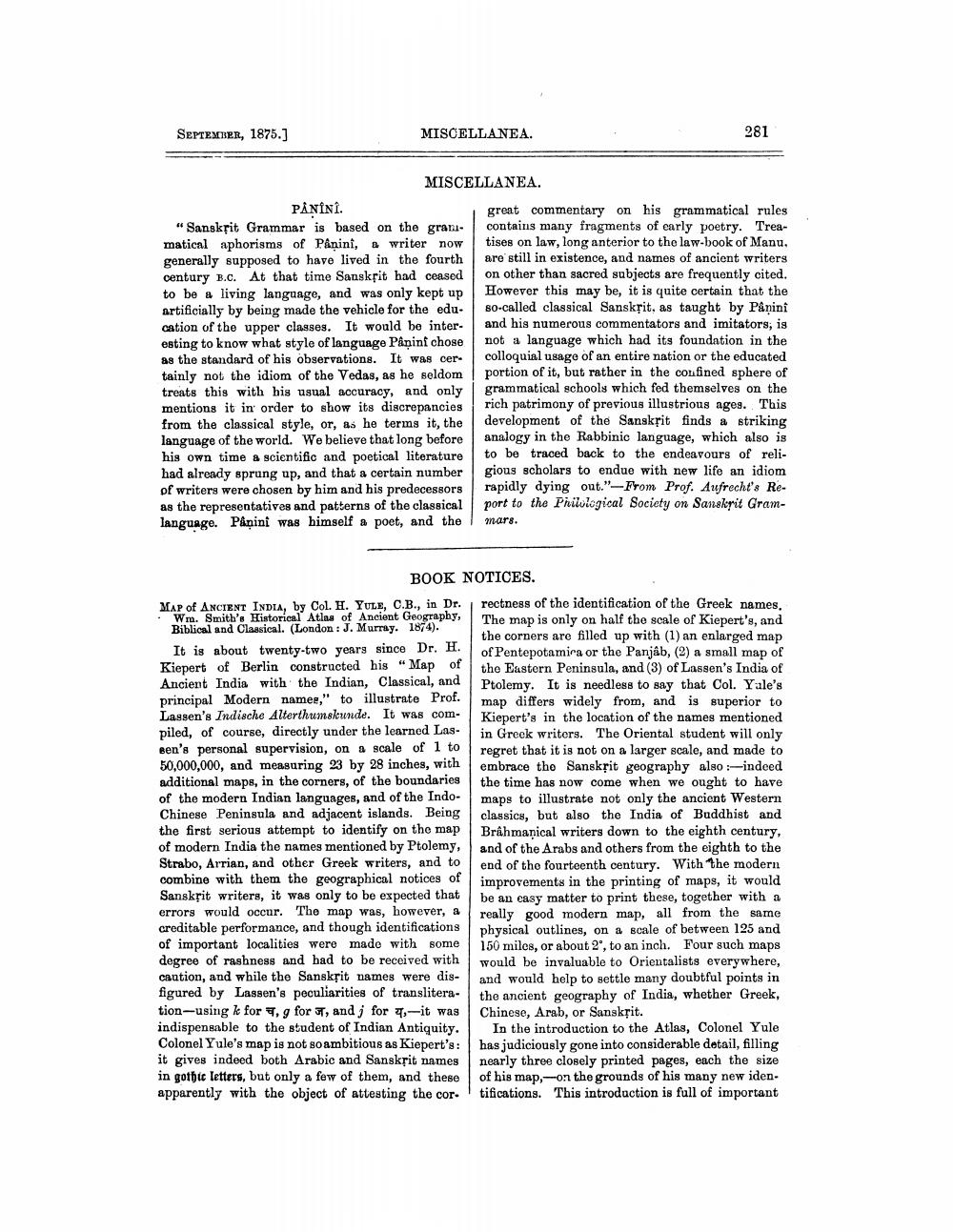________________
SEPTEMBER, 1875.]
MISCELLANEA.
MISCELLANEA.
PANINI.
"Sanskrit Grammar is based on the grammatical aphorisms of Panini, a writer now generally supposed to have lived in the fourth century B.C. At that time Sanskrit had ceased to be a living language, and was only kept up artificially by being made the vehicle for the education of the upper classes. It would be interesting to know what style of language Pânini chose as the standard of his observations. It was certainly not the idiom of the Vedas, as he seldom treats this with his usual accuracy, and only mentions it in order to show its discrepancies from the classical style, or, as he terms it, the language of the world. We believe that long before his own time a scientific and poetical literature had already sprung up, and that a certain number of writers were chosen by him and his predecessors as the representatives and patterns of the classical language. Panini was himself a poet, and the
BOOK
MAP of ANCIENT INDIA, by Col. H. YULE, C.B., in Dr. Wm. Smith's Historical Atlas of Ancient Geography, Biblical and Classical. (London: J. Murray. 1874).
It is about twenty-two years since Dr. H. Kiepert of Berlin constructed his "Map of Ancient India with the Indian, Classical, and principal Modern names," to illustrate Prof. Lassen's Indische Alterthumskunde. It was compiled, of course, directly under the learned Lassen's personal supervision, on a scale of 1 to 50,000,000, and measuring 23 by 28 inches, with additional maps, in the corners, of the boundaries of the modern Indian languages, and of the IndoChinese Peninsula and adjacent islands. Being the first serious attempt to identify on the map of modern India the names mentioned by Ptolemy, Strabo, Arrian, and other Greek writers, and to combine with them the geographical notices of Sanskrit writers, it was only to be expected that errors would occur. The map was, however, a creditable performance, and though identifications of important localities were made with some degree of rashness and had to be received with caution, and while the Sanskrit names were disfigured by Lassen's peculiarities of transliteration-using k for, g for, and j for 4,-it was indispensable to the student of Indian Antiquity. Colonel Yule's map is not so ambitious as Kiepert's: it gives indeed both Arabic and Sanskrit names in gothic letters, but only a few of them, and these apparently with the object of attesting the cor
281
great commentary on his grammatical rules contains many fragments of early poetry. Treatises on law, long anterior to the law-book of Manu. are still in existence, and names of ancient writers on other than sacred subjects are frequently cited. However this may be, it is quite certain that the so-called classical Sanskrit, as taught by Pâninî and his numerous commentators and imitators, is not a language which had its foundation in the colloquial usage of an entire nation or the educated portion of it, but rather in the confined sphere of grammatical schools which fed themselves on the rich patrimony of previous illustrious ages. This development of the Sanskrit finds a striking analogy in the Rabbinic language, which also is to be traced back to the endeavours of religious scholars to endue with new life an idiom rapidly dying out."-From Prof. Aufrecht's Report to the Philological Society on Sanskrit Gram
mars.
NOTICES.
rectness of the identification of the Greek names. The map is only on half the scale of Kiepert's, and the corners are filled up with (1) an enlarged map of Pentepotamira or the Panjab, (2) a small map of the Eastern Peninsula, and (3) of Lassen's India of Ptolemy. It is needless to say that Col. Yale's map differs widely from, and is superior to Kiepert's in the location of the names mentioned in Greek writers. The Oriental student will only regret that it is not on a larger scale, and made to embrace the Sanskrit geography also:-indeed the time has now come when we ought to have maps to illustrate not only the ancient Western classics, but also the India of Buddhist and Brahmaṇical writers down to the eighth century, and of the Arabs and others from the eighth to the end of the fourteenth century. With the modern improvements in the printing of maps, it would be an easy matter to print these, together with a really good modern map, all from the same physical outlines, on a scale of between 125 and 150 miles, or about 2°, to an inch. Four such maps would be invaluable to Orientalists everywhere, and would help to settle many doubtful points in the ancient geography of India, whether Greek, Chinese, Arab, or Sanskrit.
In the introduction to the Atlas, Colonel Yule has judiciously gone into considerable detail, filling nearly three closely printed pages, each the size of his map,-on the grounds of his many new identifications. This introduction is full of important




